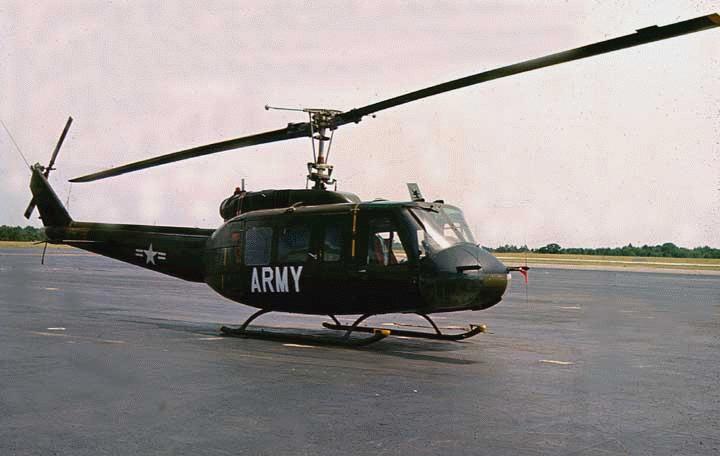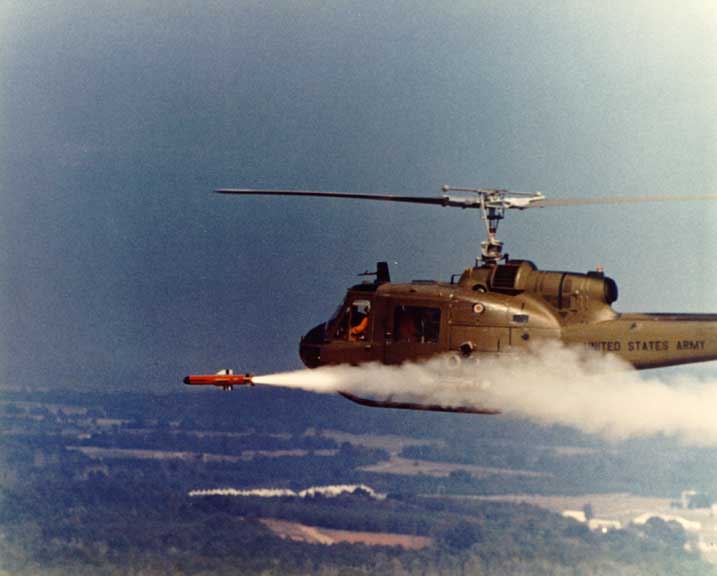
YAKIMA, Wash. -- An icon of the Vietnam War, a faithful conveyer of American troops across the globe and savior to countless lost or injured civilians, the Huey helicopter's long Army service is ending.
For the medevac detachment at the Army's Yakima Training Center, that distinguished career concluded Wednesday.
More than 50 years after the first models lifted off, the Army is retiring the few single-bladed UH-1 variants still sitting on the flightline.
Wednesday's retirement ceremony at the training center was a bittersweet moment for the pilots, crewmen and passengers who came to know the Huey as a reliable machine for both combat missions and stateside duties, most notably civilian search and rescue.
Chief Warrant Officer Joseph Long, part of the Training Center's Air Ambulance Detachment, is probably one of the last Vietnam-era Huey pilots serving today. He was recalled to active duty in 2002 because the Army didn't have enough Huey-trained pilots.
Long had the honor of piloting the last formal Huey mission at the training center as part of the flyaway retirement ceremony on the parade ground. Sitting on his left was retired Lt. Col. Bruce Crandall, who received the Medal of Honor for flying 70 wounded troops out of Vietnam's Ia Drang Valley in 1965.
Long said newer helicopters have been threatening to push the Huey out of service for 30 years.
"It just never happened," Long said. "It was always pulling a mission."
The Huey is considered the most widely known modern helicopter, thanks to numerous Hollywood depictions and the characteristic "whoop-whoop-whoop" sound made by the spinning main rotor.
"It's an iconic aircraft. It's an amazing thing to be able to fly something that everybody knows," said Maj. George Johnson, commanding officer of the training center's medevac detachment.
The Huey was well known in its role as a medevac chopper and its pilots earned a reputation as the "cowboys of aviation" for their willingness to fly whenever, wherever, however if somebody needed help under fire. The bird was nicknamed "Dustoff" for the cloud of dirt kicked up on takeoff, a name still given to medevac crews. But the Huey also served as a troop transport and air assault platform, part of the military's decision to broaden the Army's aviation aspect for the "helicopter war" in Vietnam.
Seven thousand flew in Vietnam; more than 16,000 were made. The Huey differed from its predecessors by use of a turbo-shaft engine that took up less space.
"There's no doubt that without this aircraft, we couldn't have done what we did there in Vietnam," said retired Col. Phillip Courts, commander of the Army's Ninth Aviation Brigade in Vietnam and a guest speaker at Wednesday's ceremony.
Courts told how he once led a group of 35 Hueys from Fort Lewis to Portland before heading east along the Columbia River on their way to the training center. Hoping to find a path through bad weather, he punched ahead of the rest of the choppers but ended up having to land. The crew spent the night grounded and then flew toward Union Gap, where a shortage of fuel forced him to land short of his destination.
"I had to live with that for several years, but the story ended well," Courts said.
Many who boarded the Huey could tell the same story. Even when the Huey crashed, it often held together well enough to spare the occupants from major injury.
Don Morris, a retired Army command sergeant major from Ellensburg, on Wednesday recalled surviving crashes in the jungle and a rice paddy.
"They could take the abuse and keep on going," Morris said.
Other helicopters carry more technology and are better outfitted for today's military. But fans of the original Huey know that their favorite helicopter could stay in the air for another 20 years. The seven Hueys in the training center fleet will be turned over to the Air Force to serve as training aircraft.
At least will two remain in service at Fort Rucker, Ala., the epicenter of the Army's aviation program, an Army spokeswoman said.
Even though Wednesday's retirement flight was limited by fog, Crandall said he still enjoyed the chance to go up one more time in an active-duty Huey.
"That's the best helicopter ever built up to now," he said.
--------------------------------------------
---------- Post added at 08:58 AM ---------- Previous post was at 08:55 AM ----------
Overview:
The most widely used military helicopter, the Bell UH-1 series Iroquois, better known as the "Huey", began arriving in Vietnam in 1963. Before the end of the conflict, more than 5,000 of these versatile aircraft were introduced into Southeast Asia. "Hueys" were used for MedEvac, command and control, and air assault; to transport personnel and materiel; and as gun ships. Considered to be the most widely used helicopter in the world, with more than 9,000 produced from the 1950s to the present, the Huey is flown today by about 40 countries.
Bell (model 205) UH-1D (1963) had a longer fuselage than previous models, increased rotor diameter, increased range, and a more powerful Lycoming T53-L-11 1100 shp engine, with growth potential to the Lycoming T53-L-13 1400 shp engine. A distinguishing characteristic is the larger cargo doors, with twin cabin windows, on each side. The UH-1D, redesigned to carry up to 12 troops, with a crew of two, reached Vietnam in 1963. The UH-1D has a range of 293 miles (467km) and a speed of 127 mph (110 knots). UH-1Ds were build under license in Germany. UH-1D "Hueys" could be armed with M60D door guns, quad M60Cs on the M6 aircraft armament subsystem, 20mm cannon, 2.75 inch rocket launchers, 40mm grenade launcher in M5 helicopter chin-turret, and up to six NATO Standard AGM-22B (formerly SS-11B) wire-guided anti-tank missiles on the M11 or M22 guided missile launcher. The UH-1D could also be armed with M60D 7.62mm or M213 .50 Cal. pintle-mounted door guns on the M59 armament subsystem. The MedEvac version UH-1V could carry six stretchers and one medical attendant. Bell (model 205A-1) UH-1H (1967-1986) was identical to the UH-1D but was equipped with an upgraded engine that allowed transport of up to 13 troops. The UH-1H has a two-bladed semi-rigid seesaw bonded all metal main rotor and a two-bladed rigid delta hinge bonded all metal tail rotor. The UH-1H is powered by a single Lycoming T53-L-13B 1400 shp turboshaft engine. More UH-1H "Hueys" were built than any other model. The UH-1H was licensed for co-production in the Republic of China (Taiwan) and in Turkey. UH-1H "Nighthawk" was equipped with a landing light and a pintle mounted M134 7.62mm "minigun" for use during night interdiction missions. The AH-1G Cobra was often flown on night "Firefly" missions using the UH-1H "Nighthawk" to locate and illuminate targets.
The UH-1N is a twin-piloted, twin-engine helicopter used in command and control, resupply, casualty evacuation, liaison and troop transport. The Huey provides utility combat helicopter support to the landing force commander during ship-to-shore movement and in subsequent operations ashore.he aircraft can be outfitted to support operations such as command and control with a specialized communication package (ASC-26), supporting arms coordination, assault support, medical evacuation for up to six litter patients and one medical attendant, external cargo, search and rescue using a rescue hoist, reconnaissance and reconnaissance support, and special operations using a new navigational thermal imaging system mission kit.
The goal of the USMC H-1 Upgrades Program is to achieve a platform that meets the growing needs of the Marine Corps. The 4BW and 4BN will be an upgraded version of the current AH-1W and UH-1N Helicopters. The 4BW and 4BN will share a common engine, Auxiliary Power Unit, four-bladed main and tail rotor system, transmission, drive train, and tail boom. The purpose of these modifications is to achieve commonality in both aircraft, thereby reducing logistical support, maintenance workload, and training requirements. The replacement of the two bladed rotor system with a common four bladed rotor system will achieve improved performance, reliability, and maintainability. The addition of an infrared suppresser to the aircraft will improve survivability. The 4BW will also include a newly developed cockpit, which will result in nearly identical front and rear cockpits that simplify operator and maintainer training and maintenance.


---------- Post added at 09:00 AM ---------- Previous post was at 08:58 AM ----------
---------------------------------
Specifications::
Primary function Utility helicopter
Manufacturer Bell Helicopter Textron
Power plant Pratt and Whitney T400-CP-400
Power Burst: 1290 shaft horsepower (transmission limited)
Continuous: 1134 shaft horsepower (transmission limited)
Length 57.3 feet (17.46 meters)
Height 14.9 feet (4.54 meters)
Rotor Diameter 48 feet (14.62 meters)
Speed 121 knots (139.15 miles per hour) at sea level
Ceiling 14,200 feet (4331 meters)
(limited to 10,000 feet (3050 meters) by oxygen requirements)
Maximum takeoff weight 10,500 pounds (4,767 kilograms)
Range 172 nautical miles (197.8 miles)
Crew Officer: 2
Enlisted: 2
Armament
* M-240 7.62mm machine gun or
* GAU-16 .50 caliber machine gun or
* GAU-17 7.62mm automatic gun
All three weapons systems are crew-served, and the GAU-2B/A can also be controlled by the pilot in the fixed forward firing mode.
* The helicopter can also carry two 7-shot or 19-shot 2.75" rocket pods.
Introduction date 1971
Unit Replacement Cost $4,700,000
